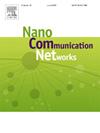Isolation enhancement in a tunable wideband THz MIMO DRA with polarization and pattern diversity without using decoupling element
IF 4.7
4区 计算机科学
Q2 ENGINEERING, ELECTRICAL & ELECTRONIC
引用次数: 0
Abstract
Isolation between the ports of a two-port terahertz (THz) multi-input, multi-output (MIMO) dielectric resonator (DR) antenna (DRA) is enhanced using a newly implemented technique which has been numerically analysed. Frustum geometry of DRs can provide the high isolation without requiring the separation distance between the radiators. The minimum isolation between the ports is enhanced to 21 dB in the case of frustum geometry of the DRs which remains around 12 dB in the case of conventional cylindrical DRs over a wide impedance bandwidth of THz. The orthogonal feeding arrangement is utilized to find the polarization diversity in antenna. The operation of antenna with multiple modes equivalent to the vertical electric dipoles of fundamental and higher order offers the radiation patterns with peaks off to the boresight axis which are resultantly organized to find the pattern diversity in antenna. The circuit analysis validates the antenna operation. The radiating surface of the DRs is coated with graphene that can provide the electrically tunable response over a wide frequency range. Setting the adequate surface conductivity of graphene can provide the dual mode operation of antenna with the capability of MIMO and self-diplexing with high gain around 6 dBi. The MIMO parameters like envelope correlation coefficient and diversity gain are found <0.1 and >9.98, respectively.
带极化和模式分集的可调谐宽带太赫兹MIMO DRA的隔离增强
利用一种新实施的技术增强了双端口太赫兹(THz)多输入多输出(MIMO)介质谐振器(DR)天线(DRA)端口之间的隔离度,并对该技术进行了数值分析。DR 的浮士德几何形状可以提供高隔离度,而不需要辐射器之间的分离距离。在 2.71-3.69THz 的宽阻抗带宽内,DR 的挫面几何形状可将端口之间的最小隔离度提高到 21 dB,而传统圆柱形 DR 的隔离度仅为 12 dB 左右。利用正交馈电安排来实现天线的极化分集。天线的工作模式相当于基阶和高阶的垂直偶极子,其辐射模式的峰值偏离镗孔轴,从而使天线的模式多样化。电路分析验证了天线的工作原理。DR 的辐射表面涂有石墨烯,可以在很宽的频率范围内提供电可调响应。设置适当的石墨烯表面电导率可实现天线的双模运行,具有多输入多输出(MIMO)和自双工(self-iplexing)能力,增益约为 6 dBi。包络相关系数和分集增益等 MIMO 参数分别为 0.1 和 9.98。
本文章由计算机程序翻译,如有差异,请以英文原文为准。
求助全文
约1分钟内获得全文
求助全文
来源期刊

Nano Communication Networks
Mathematics-Applied Mathematics
CiteScore
6.00
自引率
6.90%
发文量
14
期刊介绍:
The Nano Communication Networks Journal is an international, archival and multi-disciplinary journal providing a publication vehicle for complete coverage of all topics of interest to those involved in all aspects of nanoscale communication and networking. Theoretical research contributions presenting new techniques, concepts or analyses; applied contributions reporting on experiences and experiments; and tutorial and survey manuscripts are published.
Nano Communication Networks is a part of the COMNET (Computer Networks) family of journals within Elsevier. The family of journals covers all aspects of networking except nanonetworking, which is the scope of this journal.
 求助内容:
求助内容: 应助结果提醒方式:
应助结果提醒方式:


